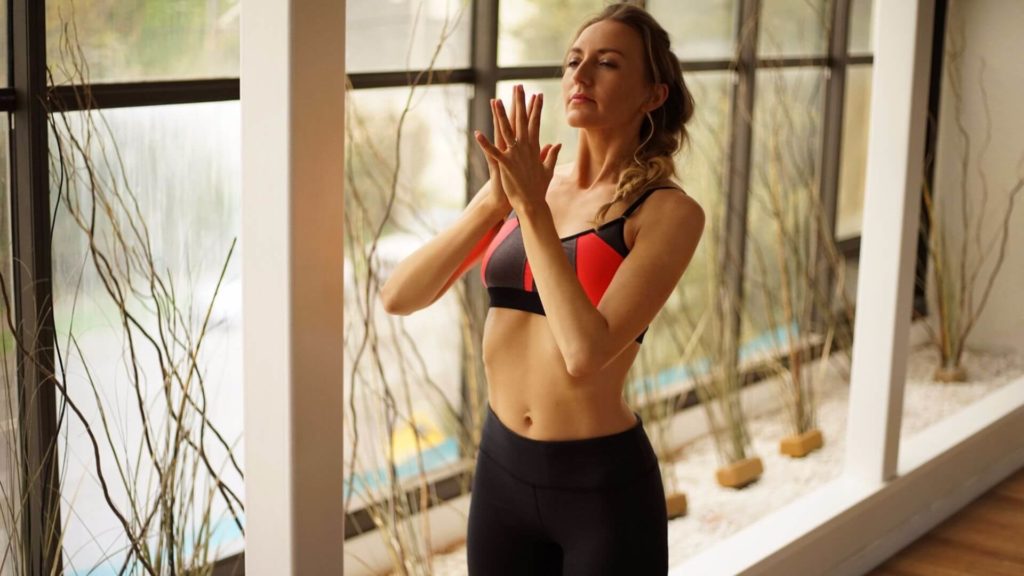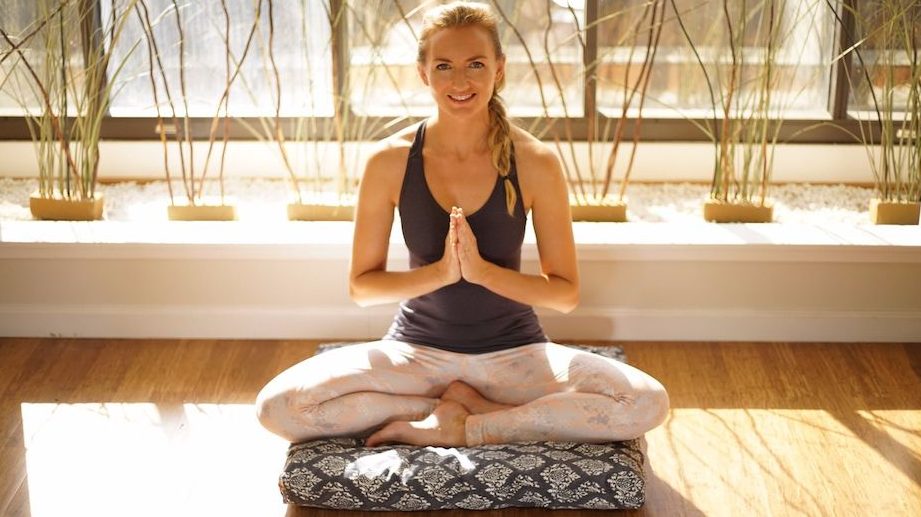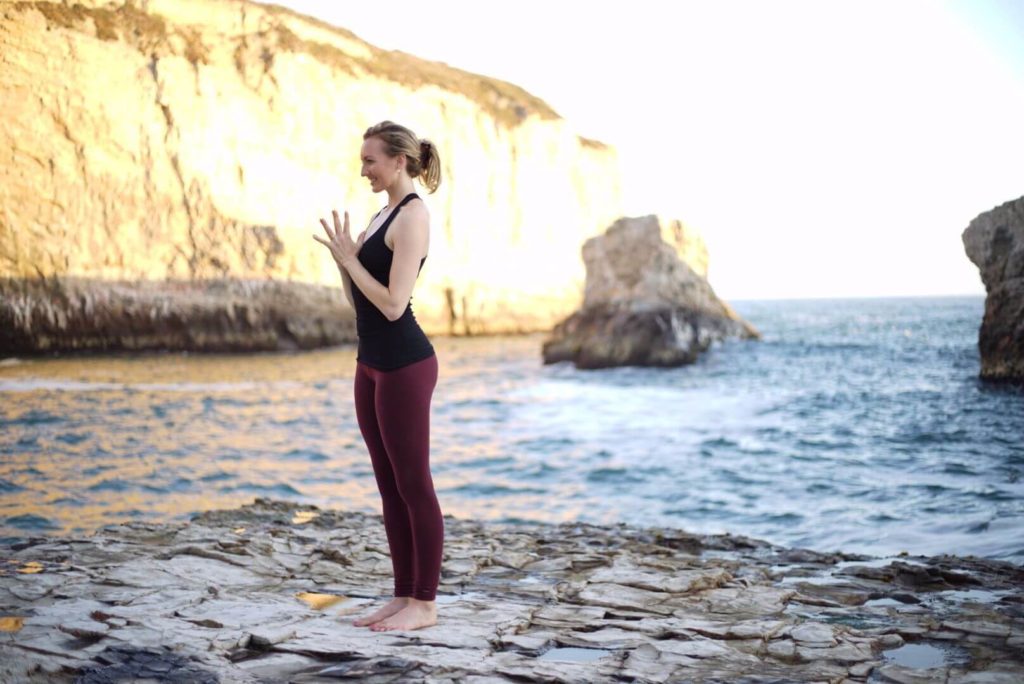
If you’ve been to any yoga class, you’ve probably encountered the simple gesture of joining the hands at the heart center. Even if you haven’t taken a yoga class, you’ve probably seen this movement in everyday life with movies, tv shows, or prayer positions.
You’ll often see this posture during pranayama and asana practices or when your yoga teacher begins and concludes the class while accompanying it with a ‘Namaste’. You’ve maybe heard this position called the Namaste mudra or simply prayer hands.
So what does the gesture actually mean?
Well, this hand position is officially called anjali mudra and is a holy hand gesture in the Eastern culture. It teaches us how to embody respect and bring consciousness to the present moment. It is also used to greet people, or as a sign of farewell, honor, and appreciation that transcends cultures and languages, uniting people all over the world.
Pretty powerful, right!?
In this article, we’ll dive a little bit more into what this Mudra actually means, its history, benefits, and how to do it.
What Does Anjali Mudra Mean?
In a nutshell, anjali mudra is one of the sacred hand gestures that guide us to appreciate and embrace the present moment.
The Sanskrit word anjali stands for “to offer” or “to salute”, while Mudra means “seal.”
To get the full benefit of yoga, it’s essential to do your yoga practice mindfully and with a purpose, rather than just going through the motions. The namaste mudra enhances and further promotes the idea of applying meaning to all our physical expressions. It helps us observe any subtle differences that take place in our mental and emotional body and resonate with our inner attitude.
This gesture is interpreted as a worship body position in the Western world. We’ve probably all seen the anjali mudra in life, whether we knew what it was or not, so we all likely have our own subjective associations with it.
For some people, the joined hands resemble surrender and have an aversion to that. On the other hand, others can associate this gesture with equality, universal connectedness, and appreciation towards everything around them.
The anjali mudra is just one of the thousands of mudras used in Hindu rituals, Indian folk dances, and yoga. This mudra often goes along with the word “namaste”, which translates as “I bow to the divinity within you from the divinity within me.”
The ability to witness the Divine amongst all living things encapsulates the lifeblood of yoga, so it makes sense why this mudra and the word “namaste” is a staple in most people’s yoga practices!

The History Behind the Prayer Posture
The anjali mudra shows up all over the place in historical texts including temple architecture texts such as the Devata murti prakarana (verse 5.67) and Sanskrit treatises, called Citrasutras. The namaste gesture also comes up in the Natya Shastra, a classical Indian dance text, as a body position in which the two hands are folded together in a gracious manner which is used to worship a deity, receive embraces, and salute friends.
In practice, people will often position the hands in anjali mudra adjacent or above the head for prayers within a temple, in front of the forehead or chin for encountering a respected individual, and in front of the chest for a more personal connection with friends and family.
The anjali mudra has had many names throughout history such as “hrdayanjali mudra”, which translates to “reverence to the heart seal”, and “atmanjali mudra”, which translates to “reverence to the self seal”.
This mudra is also associated with the myth about the birth of Patanjali whose name means “one who fell into hands placed in reverence.” Some myths say he landed as a tiny snake in the hands of his mother who was making an offering, and he was received as a gift from the heavens.
At a base level, the anjali mudra connects the two sides of the body by uniting the hands. Some people see this as a symbol for the two poles of duality, prana and citta shakti, yin and yang, or our outer and inner selves. In all these symbols, when the hands come together, they create wholeness.
The formation of a minor concave shape in the center of the palms symbolizes the space we hold inside, which is ready to give and receive. When we achieve the union of the two selves (putting the hands together) then our offering and receiving will be holy.
What Are the Benefits of the Anjali Mudra?
There are a ton of benefits of the anjali mudra!
Using this mudra during yoga asanas boosts our concentration, assists our grounding, brings awareness to our intention, and helps us to recognize the meaning of the postures.
And if that’s not enough, these are other benefits that can come with the anjali mudra:
- The anjali mudra momentarily streams our thought process by unifying the right and left hemispheres of our brain. This can boost our coordination, have an overall calming effect, and lead to a blast of positive thinking during the physical yoga practice.
- The connection of the prayer position with mindful and steady deep breaths can pacify the mind, relieve stress, and enhance the circulation of oxygen in the blood.
- If the anjali mudra is practiced regularly then it can increase the concentration, the mindful connection to the other yoga asanas, and the awareness of the present moment.
- Physically, pressing the base of your hands together, while you gently touch your fingertips, expands the space between the shoulder blades, helps you keep the chest open, and stretches the wrists.
Finally, the five elements that comprise the whole universe are linked with our fingers:
- Agni (fire) — thumb
- Vayu (air) — index finger
- Aakash (space) — middle finger
- Prithvi (earth) — ring finger
- Jal (water) — little finger
Anjali Mudra therefore stimulates the five elements within our body. When we practice the mudra regularly, we harmonize the organs associated with these elements and achieve an inner state of dynamic equilibrium.
How to Do the Anjali Mudra
Now that you know all the sweet benefits that can come from this mudra, are you ready to give it a try? Let’s do it!
- Slowly bring your palms together in front of your heart center (heart chakra). By keeping the forearms parallel to the floor you will feel a stretch in the wrists. This posture guides your awareness towards your heart center.
- Press lightly at the fingertips, while all fingers point upward. Connect the tip of all fingers and the outline of your palms, and allow the natural creation of a small hollow between the centers of the palms. There you can experience the energy of your hands manifesting in the form of heat in your palms.
- Lengthen your spine. Reach up through the crown of your head and relax your shoulders. Keep your shoulders away from your ears, while you slowly draw them back and down.
- From here, you can continue with your hands at your heart center or practice the mudra at your third eye or practice “reverse anjali mudra.”
- Bringing your anjali mudra to your third eye (Ajna chakra) will direct your focus towards your intuition. At the same time, tuck your chin slightly and perform a bowing gesture.
- To practice “reverse anjali mudra,” roll your shoulders down and back and let your chest expand. Then press your palms together behind your back, ideally in between your shoulder blades.
Beginner’s Tip: Place your hands together with minimal effort. Let their warmth circulate in the empty space between your palms. If you get tired, then let your hands rest on your lap while maintaining the mudra.
Anjali mudra is commonly used to start and end the yoga class. It assists the grounding of the individual and the arrival on the mat, as well as the establishment of the intention.
This mudra can be performed in a comfortable sitting position, during meditation practice, as well as in several different asanas, and it can call attention to stay present, and maintain humility and serenity throughout the practice.
Anjali mudra is frequently used in the following asanas:
- Mountain pose (Tadasana)
- Prior to Sun Salutations — more specifically Surya Namaskar A and B
- In any posture that challenges and strengthens our ability to balance, such as tree pose (Vrksasana), which requires greater concentration.
There are also several occasions where you can integrate the prayer hand gesture in your everyday life, such as when expressing grace before meals, achieving truthful and respectful interactions, and when you need a moment to calm yourself from your daily rush.
Anjali mudra is a centuries-old technique for reminding people to appreciate the meaning of being alive and connect to the present moment — simply by bringing hands together.
Next Steps
- If you’re interested in practical kriya yoga as a way to improve your daily life and relationships, check out my Yoga for Self Mastery course.
- Order my Yoga Life book for a practical guide to creating balance in your life through yoga.
- Check out my YouTube channel and find some yoga classes that you can try out for yourself!
Experience 3 Training Videos from Inside My 200-Hour Online YTT

YOU MIGHT ALSO LIKE
- 8 Kundalini mudras for health and energy
- Vitarka Mudra: What It Is and How Do You Use It?
- Shakti Mudra: What It Is and How Do You Do It?
- Garuda Mudra: What It Is and How Do You Use It?
- Kali Mudra: What It Is and How Do You Do It?
- Shunya Mudra: What It Is and How Do You Do It?
- Varuna Mudra: What It Is and How Do You Use It?
- Vayu Mudra: What It Is and How Do You Use It?
- Venus Mudra: The Seal of Clarity & Empowerment
- Karana Mudra: What Is It And How Do You Use It?
- Gyan Mudra: What Is It And How Do You Use It?
- Dhyana Mudra: What Is It And How Do You Use It?
- Lotus Mudra: What Is It And How Do You Do It?
- Dharmachakra Mudra: What Is It And How Do You Do It?
- Yoni Mudra: What Is It And How Do You Use It?
- Apana Mudra: What Is It And How Do You Use It?
- 10 Powerful Types of Mudras (With Pictures)
Learn how to do 11 of the most popular yoga poses correctly. Free video + PDF download.













